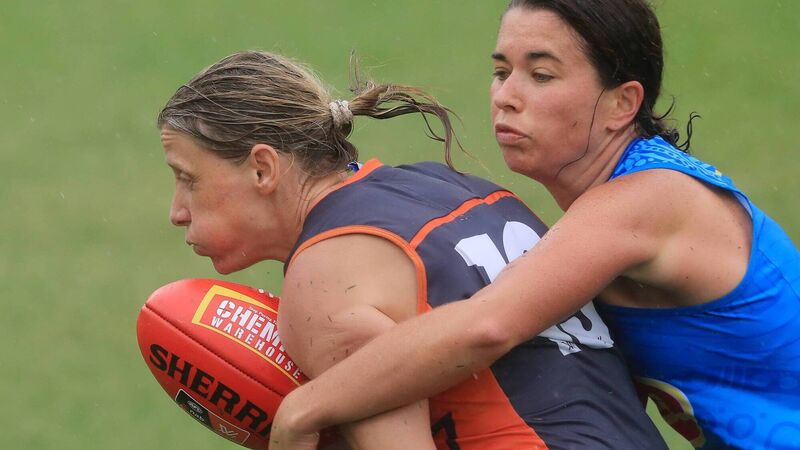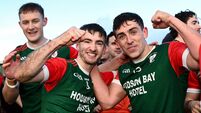Eimear Ryan: What if camogie was formed in a more progressive age - like AFLW?

Cora Staunton of the Giants contests the ball with Lauren Ahrens of the Suns during the opening round of the AFLW last February. Picture: Mark Evans/Getty Images
It was fascinating to watch Sinead Goldrick’s Instagram stories (@goldieface6_) in early January, as she documented her two-week compulsory quarantine in a Melbourne hotel.
Shortly after winning her fourth All-Ireland medal with Dublin, she arrived in Australia for her second season with the Melbourne Demons.
In her hotel room, she had an exercise bike and weights, and cleared a path from window to door for shuttle runs.
Dispiriting hotel meals were delivered to her door. Her Macbook and her phone — as well as an impressive city view from her window — became her portals on the world.
This is the strange set of circumstances that 14 Irishwomen grappled with last month, all for the privilege of playing pro ball on another continent in the midst of a pandemic.
TG4, bless them, are filling a gap in their excellent coverage of ladies football by broadcasting AFLW matches every Saturday afternoon — the delightfully-titled Aussie Rules na mBan — plus a round-up show on Mondays. With nearly enough Irish players that they could field a team on their own, there’s bound to be Irish representation in any given match-up. (Last Saturday’s game, the Adelaide Crows against the West Coast Eagles, had four: Tipp’s Aisling McCarthy and Mayo sisters Niamh and Grace Kelly for the Eagles, with Clare’s Ailish Considine lining out for the Crows.) In a time when we’re craving live GAA, not to mention sunshine, watching ladies footballers ply their trade Down Under at the height of summer is a tonic. You could nearly soak up the vitamin D by proxy.
The sport is relatively new to me, but I’m gripped, down to the same-but-different terminology. Disposals, not passes. Smothers, not blocks. A league ladder rather than a table. It’s interesting, too, to watch how Gaelic football intersects with Aussie rules — figuring out the X factor that the Irish players bring.
While AFL is a more physical game than football, the skill levels of the Irish players — in particular their kicking and catching ability — is well above the norm.

You can tell too, sometimes, when the Gaelic football calibration doesn’t quite translate to AFL. West Coast’s Niamh Kelly — who had a strong start to her season, scoring a goal and a behind — at one stage went to take what in Gaelic football would be a steadying bounce; not so in AFL, where the funny-shaped ball has a mind of its own.
The Irish contingent are not the only players transitioning from another sport.
Basketball players, baseball players, footballers of different codes, and even surfers have all made their way into the AFLW.
The talent agency CrossCoders actively seeks out talented female athletes worldwide to recruit into the league. What they’re offering is a lifestyle: the chance to focus solely on sport, to be paid, to have access to professional facilities — and all in a sunny climate. That so many female athletes opt in perhaps serves to highlight the scarcity of meaningful professional team sport opportunities for women elsewhere.
This is only the league’s fifth season, and there are advantages to its relative youth. In this day and age, it’s only natural to treat women the same as men, and so the female AFLW players have equal access to facilities as their male counterparts, and media coverage has been equitable from the get-go.
However, they still lag behind on perhaps the most pertinent metric of all: cold hard cash. On average, AFL players make somewhere between $300,000 and $400,000. While salaries for AFLW players have increased since the league began in 2017, their top players make somewhere in the region of $30,000 — and many players still need part-time work outside of footie to make ends meet.
Still, making a modest wage seems like a pretty great deal compared to our women’s team sports, where players are all too often out of pocket for playing for their county.
It seems counterintuitive that women’s Aussie rules could be more progressive than a sport with as long and proud history as camogie, but that’s the case.
History can be a burden as well as a benefit, baggage as well as inspiration. Camogie was founded and developed in an era when equal treatment for women was rarely even considered, much less expected.
That camogie would play second fiddle to hurling was the natural order, and it takes a long time to unpick that kind of hierarchy.
Despite the progress that has been made in recent years, it’s always worth reminding ourselves that it wasn’t until 1998 that the All-Ireland camogie final was broadcast live, and it wasn’t until 2016 that any camogie championship match aside from the final was televised.
I still sometimes feel a pang when I consider the fact that ladies football has by now, thanks to TG4, 20 years of footage in the can for posterity, while we have scarcely any videos of some of the greatest camogie players of the modern age.
We should be able to type Claire Grogan or Mary O’Connor into YouTube and get a wealth of clips.
It’s striking, too, to listen to the AFLW commentators. They can be quite critical at times, bluntly calling out bad misses, poor decisions, and simulation, as well as praising the good stuff.
This also differs from coverage of women’s sport in Ireland. While the analysis is often excellent, there’s sometimes a reluctance to critique — perhaps due to the guilty knowledge that we have not given these sports their due in the past, and even now the players are still striving for equity. The Aussie rules contingent — having treated their female players with respect and fairness from the outset — feel no such compunction. The benefits of a clean slate.
While it’s impossible to reset the clock, or restore the factory settings on our women’s sports, it might be worth — just as a thought experiment — considering what camogie would be like if, like women’s Aussie rules, it had been formalised in a more progressive, equitable age. Hell, if the GAA was founded today, it would include women as a matter of course. We can’t change our history, but maybe we can turn the page.







